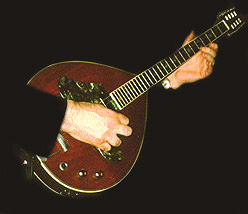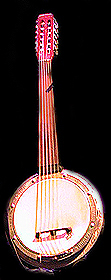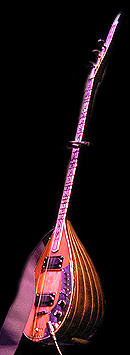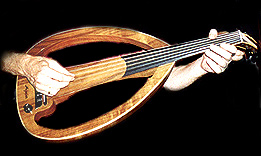 The
bouzouki is a Greek long-necked lute; the 19th-century version of it is
identical to the Turkish bouzouk. (At some point, it was the same
instrument as the saz, but the two then diverged; the Turkish saz evolved
into the Greek bouzouki, which in turn evolved into the smaller Greek baglama.)
The
bouzouki is a Greek long-necked lute; the 19th-century version of it is
identical to the Turkish bouzouk. (At some point, it was the same
instrument as the saz, but the two then diverged; the Turkish saz evolved
into the Greek bouzouki, which in turn evolved into the smaller Greek baglama.)
Traditionally, it has a carved wood or carvel-built bowl resonator (now exclusively carvel-built) shaped something like a wide teardrop, movable gut frets (now fixed metal frets), and wooden tuning pegs (now metal tuning heads). It may have three or four double courses (pairs) of metal strings, tuned e-b'-e' and d-g-b-e respectively.
The modern Greek tuning is d-a-f-c (top to bottom), the upper two courses in unison, the lower two in octaves. Nowadays, a popular tuning for three-course bouzoukis is d-a-d.
The version of the bouzouki with the four courses of strings predominates now because it is more condusive to playing Western melodies. Its sound is ringing and jangly.
Bouzoukis,
especially electric ones (like the one pictured here, which has no soundholes),
may have flat backs. Irish bouzoukis typically have flat backs.
Musicians
who use the bouzouki include:
Mikis Theodorakis, Manos Hadjidakis, Ben Mandelson, Mike Scott (of the
Waterboys), Attila the Stockbroker, Janne Lappalainen (of Värttinä),
and Eric Odier-Fink.
Links
to more information and instruction:
Wikipedia: Bouzouki history, description, links
Sam's
Bouzouki Pages (archived) history, techniques, tunings, musicians, links
Greek
Scales What's an houzam? A hijaz, or an ousak, or a niaventi?
Find out!
Kalis & Company
history, description, construction, and tunings
Ancient
Tones history and construction, with links to luthiers
Yahoo's Bouzouki links links to pages on the bouzouki
Bouzouki World
sales, info
Sources:
Sadie, Stanley, ed. The New Grove Dictionary of Musical Instruments.
London: Macmillan Press; New York: Grove's Dictionaries of
Music, 1984.
Gore,
Joe. "Mandelson & Mustafa." Guitar Player Magazine
25 (January 1991): 65-70.
About this photo: Taken March 3, 1999 at the Lemon Tree (Aberdeen, Scotland) of Ben Mandelson and his electric bouzouk.
 The
cümbüs is a Turkish long-necked lute with a circular metal bowl
resonator covered with a screw-tensioned hide soundtable. It resembles
a banjo, only with a deeper bowl resonator and a wider unfretted neck;
its sound is deeper. It has six double courses (pairs) of metal
strings attached to metal machine tuning heads. It is tuned (and
played with a quill or a plectrum) like the ud.
The
cümbüs is a Turkish long-necked lute with a circular metal bowl
resonator covered with a screw-tensioned hide soundtable. It resembles
a banjo, only with a deeper bowl resonator and a wider unfretted neck;
its sound is deeper. It has six double courses (pairs) of metal
strings attached to metal machine tuning heads. It is tuned (and
played with a quill or a plectrum) like the ud.
 courses
which sounds like a tar) and the tenorbush.
courses
which sounds like a tar) and the tenorbush. The
saz is a long-necked Turkish lute with 10-19+ movable frets made of knotted
strings. It shares an ancestor with the bouzouki, and has many different
names ("saz" merely meaning "instrument"). The neck is usually made
of fir, and the teardrop-shaped resonator is usually made of a single
piece of mulberry wood. Small soundholes may appear in the thin
wooden soundboard, and openings may also be carved in the sides of the
body. Alternately, there may be no soundholes. Strings are
either steel or brass, and are plucked by a long cherry bark plectrum.
The deepest tuning is in the middle (e.g., d'-g-a; but there are numerous
possible tunings). The sounds created by the saz are metallic and
buzzing.
The
saz is a long-necked Turkish lute with 10-19+ movable frets made of knotted
strings. It shares an ancestor with the bouzouki, and has many different
names ("saz" merely meaning "instrument"). The neck is usually made
of fir, and the teardrop-shaped resonator is usually made of a single
piece of mulberry wood. Small soundholes may appear in the thin
wooden soundboard, and openings may also be carved in the sides of the
body. Alternately, there may be no soundholes. Strings are
either steel or brass, and are plucked by a long cherry bark plectrum.
The deepest tuning is in the middle (e.g., d'-g-a; but there are numerous
possible tunings). The sounds created by the saz are metallic and
buzzing.

 The
ud is a short-necked Arabic lute, a direct ancestor of the European lute,
and very likely a relative of Chinese instruments (e.g., the Chinese pipa
lute; in addition, the tenth-century four-course ud's dominant courses
were silk, and the figures/widths of the lower two courses correspond
with the two upper strings of the Chinese qin). Its name is derived
from al-oud, "the lute." It is used primarily in Somalia,
Djibouti, and Arabic regions; it is of secondary importance in Turkey,
Iran, Armenia, and Azerbaijan. It is also used in Greece.
The
ud is a short-necked Arabic lute, a direct ancestor of the European lute,
and very likely a relative of Chinese instruments (e.g., the Chinese pipa
lute; in addition, the tenth-century four-course ud's dominant courses
were silk, and the figures/widths of the lower two courses correspond
with the two upper strings of the Chinese qin). Its name is derived
from al-oud, "the lute." It is used primarily in Somalia,
Djibouti, and Arabic regions; it is of secondary importance in Turkey,
Iran, Armenia, and Azerbaijan. It is also used in Greece.